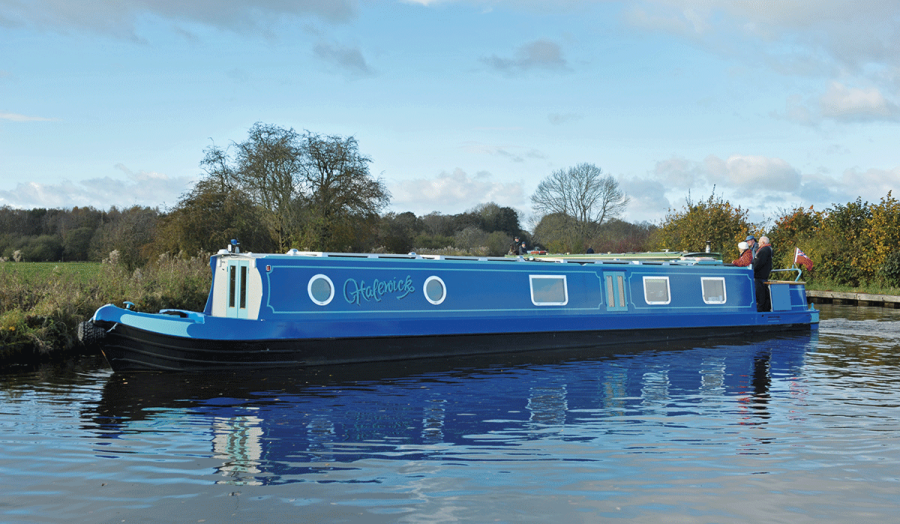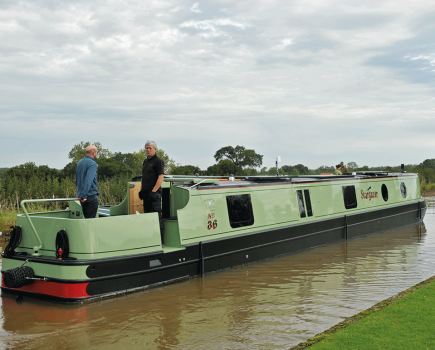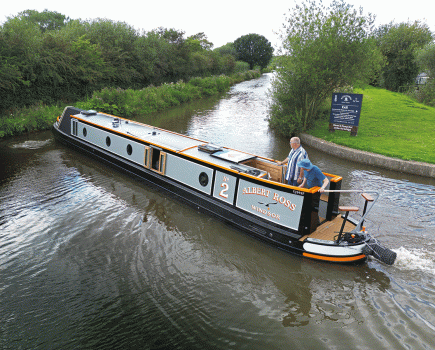But not the American media company.
Words by Adam Porters | Pictures by Andy Annable
What do you do when you’re a keen sailor, but for family reasons end up moving from the south coast to landlocked Shropshire? Well, if you’re anything like Graham Heryet, you first continue sailing on the meres, and then (obviously) you get a narrowboat to make good use of all the canals in the area.
But actually, it’s not as obvious as all that, because Graham’s wife, Sue, hates open water. She always avoided the sailing, but has agreed to narrowboating given that the canals are relatively confined areas of water, and are usually not very deep.
Graham has an engineering background, so perhaps it’s no surprise that his new boat has hybrid drive – in this case a parallel system so the boat can be driven on either diesel or electric power. He applied his knowledge to the choice of batteries, and in making sure they could be charged efficiently.
The builder is MGM, a firm which has undergone a few changes over the past few years, with Martin Parsons having retired, and Mark Fenton semi-retiring. The firm and the yard, at Thurmaston on the River Soar, is now owned by the shell builder, Nick Thorpe, so steelwork as well as fitouts can all be done on site.
EXTERIOR
Halewick is a 57ft cruiser, and while the shell is by Nick Thorpe, the shape is pure MGM. In fact, Nick has been building shells for MGM for a long time. Their winning Crick Boat Show boat in 2012 was based on one of his shells.
A particular feature which became synonymous with MGM was the large square stern, which maximises the space on the back deck. But it’s not as square as some; the corners have generous curves which should mean they don’t get bashed about quite as much. The stern is enclosed by a metal dodger topped with a broad hardwood rail giving somewhere for the crew to perch. Sue’s fear of water means there are also doors either side to completely enclose the stern to make her feel safe. Because of the angle of the dodger, the doors have to open outwards, so you do have to make sure there’s enough swinging room before you start opening them. But once open they’re properly flush against the side.
At the bow, the well deck is quite short, but it has lockers both sides and both have lockable lids. This is a gas-free boat, so the space in the nose is available for storage. The bow thruster is also in this locker, but there’s access via a hatch in the forward bulkhead. And having the thruster so far forward means the water tank, under the deck, can be as big as possible.
There are nice touches throughout, such as scrolls in the ends of the handrails, and the steelwork, as you’d expect from Nick Thorpe, looks good. The bow is a pleasant shape, and the whole boat sits very nicely in the water.
The colour scheme is very bright and cheerful, with the main colour being a mid-blue and all the highlights such as coachlines and handrails using a much paler blue. The roof and forward bulkhead are grey. It looks contemporary and fresh, and certainly stands out in a marina of darker or greyer boats. The signwriting is similarly non-traditional in style – but has been done in the traditional manner by Claire Norton of Norton Signs, who learned her art from her father.
The trim, such as the mushroom vents, are chrome, and the windows and portholes are by Caldwell’s, and are all double glazed.
LAYOUT AND FITOUT
This is a reverse layout boat, but it’s the saloon that’s at the stern with the galley in the middle of the boat, rather than the other way round which is more typical. The couple wanted their boat like this so the saloon could in effect be divided off, should they have any friends come to stay. Beyond the galley is an off-corridor shower room, with the cabin at the bow.
The fitout is very typical MGM, using ash combined with painted panels to give a very light airy feel to the interior. All the built-in furniture is well made and fits nicely. The flooring is hardwearing Karndean.
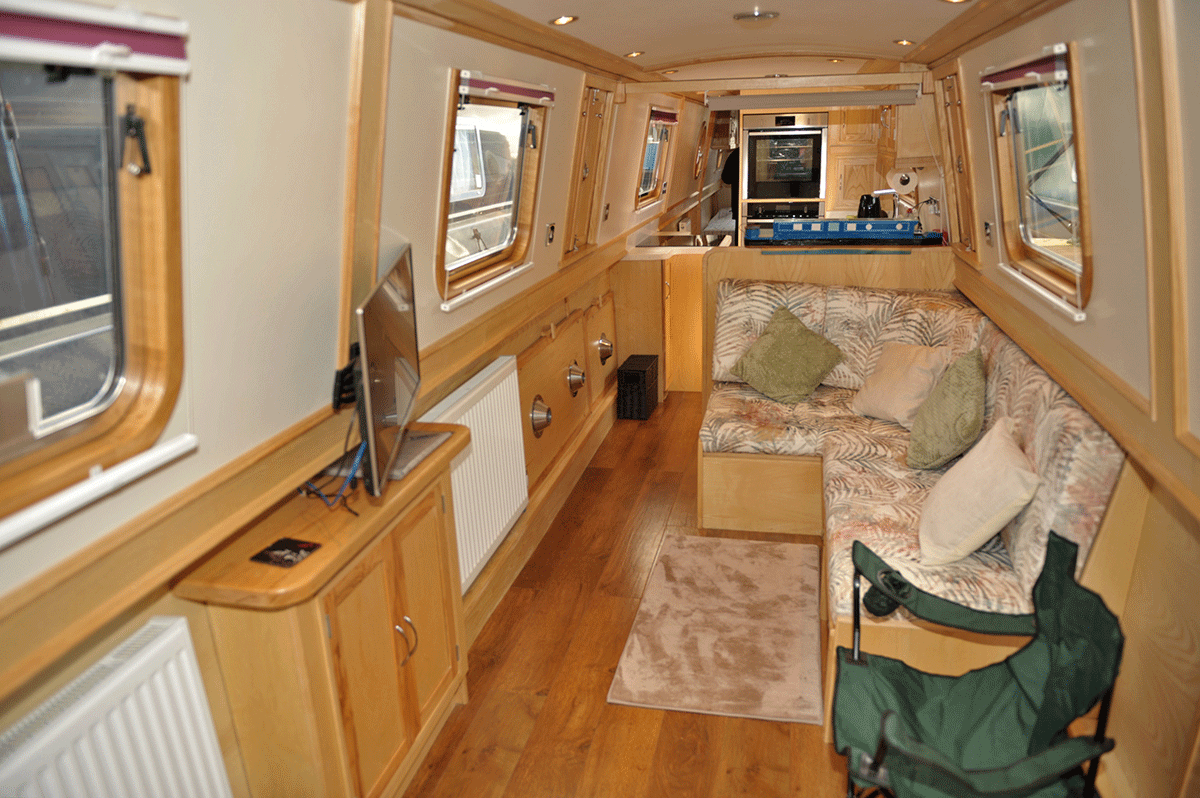
SALOON
We’ll start at the stern, where three steps lead down into the boat from the back deck. They have lifting treads for storage. The electrical cupboard is one side, with a wardrobe the other, handy for hanging coats. This side also has a tall cupboard facing into the saloon – it’s always nice to get some full-height storage.
Seating comes in the form of an L-shaped dinette. The table is mounted on Desmo legs meaning it’s easily removable and can be stored under the gunwales, (and there’s another smaller one for the back deck). The seating also converts into a guest double bed, and there’s storage in the bench seats too. Opposite, there’s an under-gunwale cupboard, with a small tv on top.
There’s also lots of open space here – which the couple are planning to fill up with a large storage box or ottoman, so any guests have somewhere to put all their stuff. At the moment, it’s also home to the box Graham has made for Sue to stand on when she’s steering, so she can see over the roof. The owners were keen to be able to give their guests some privacy, but found a curtain between the saloon and galley didn’t really work, so they have installed a roller blind. On the half-height bulkhead between the dinette and the galley is the wooden model Graham built, to show MGM what he was after. The roof lifts off so you can see the interior layout!

GALLEY
The galley is in the middle of the boat, and really feels like the heart of the home. It’s a generously sized U-shaped galley, but with a substantial unit on the opposite side. This houses a washing machine, with half-depth cupboards either side. On top is a Neff induction hob. It gives the feeling of a kitchen island (although of course a narrowboat isn’t wide enough for one of those). There’s a window above, so you get a view while cooking.
The main run of units has a 240-volt fridge at one end, then a combination of drawers and cupboards with a stainless steel sink and drainer set into the laminate worktops. There’s a high level unit here too. The oven and microwave are set against the bulkhead, in the middle of the boat. The oven is a Neff with a slide and hide door (always a good idea in the confines of a boat galley) and the microwave is by the same maker. Below is a small freezer by Abode in black, which means it matches the appliances above it. Alongside the oven, a couple of cupboards make use of the space to the cabin sides.
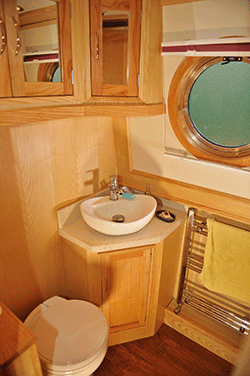 SHOWER ROOM
SHOWER ROOM
This is an off-corridor shower room. Because it doesn’t take up the full width of the boat, it’s smaller than the walk-through design we see most often these days – but it does have the advantage that there’s always a route through the boat, even if someone is using the facilities.
It’s a well designed space, with a generous 800mm square shower cubicle, lined with shower board, and with nice fittings. It has a folding door, which means it takes up less space. There’s quite a lot of room between the cubicle and the cabin sides which have been made into a cupboard and shelves.
The loo is a Thetford cassette, with access to the cassette in the corridor. There’s also a corner unit offering a useful cupboard, with a large white oval basin on top. Above, there’s a high level unit which turns into the corner, and has mirrored doors. The space under the gunwale is taken up by a heated towel rail.
CABIN
There are two single beds in the cabin, each 2ft wide. Sue made sheets to fit them properly. Each has storage in the base, and there are power sockets set into the bases too (given that there’s hardly any wall space in this room).
There’s plenty of other storage too, with a wardrobe unit which has a cupboard in the top half and drawers in the bottom half. A tv is mounted on the side, for in-bed viewing. There are also high-level cupboards both sides of the boat. The two steps up to the well deck have lifting treads.
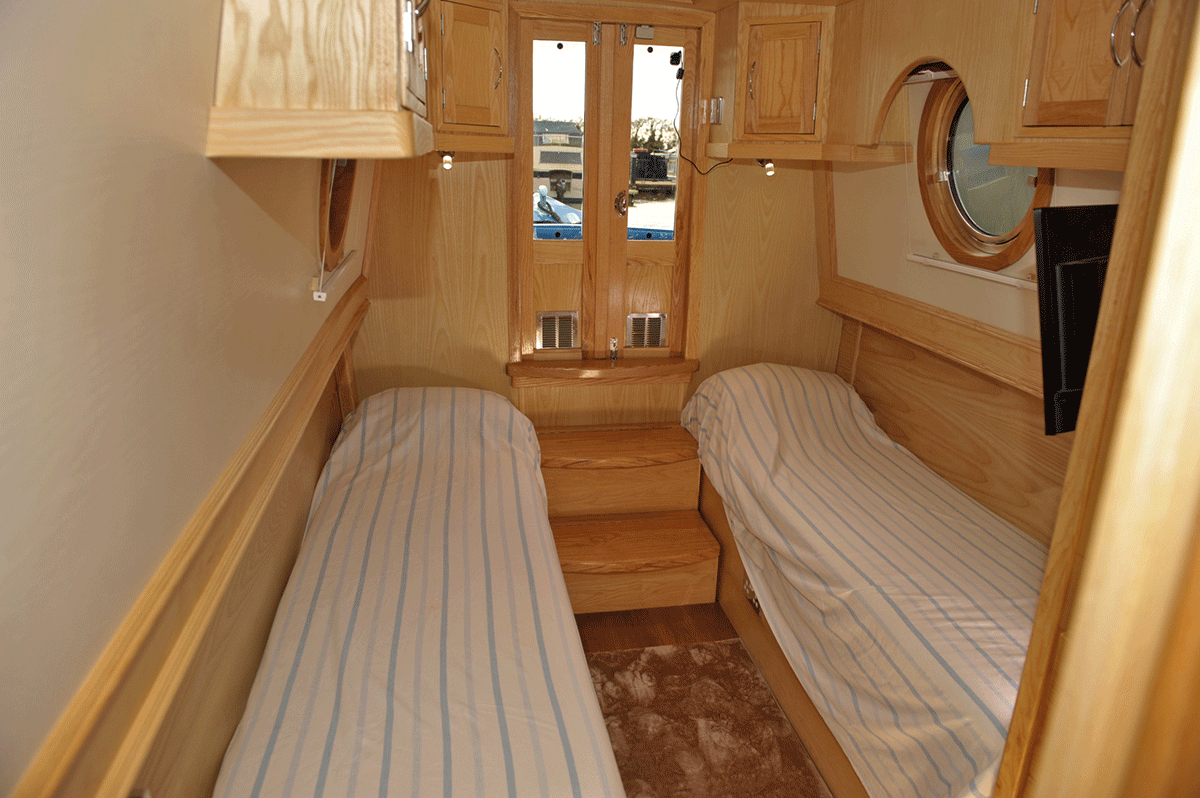
TECHNICAL
This boat is a parallel hybrid, meaning the prop can be turned by either its diesel engine or its electric motor. The system comes from Hybrid Marine, who offer set ups based either on a Beta or Barrus Shire engine. This boat has the Shire 45 option, not least because these engines have been easier to source in recent months than the Betas.
The electric motor, which is mounted on one end of the engine, is a 48-volt unit which provides 10kw of drive – but when the diesel engine is running turns into a 5kw generator to recharge the batteries. There is a Hybrid Marine control system to manage everything, and a 5kw Victron inverter to provide a 240-volt supply for all the appliances on board. In addition, there’s a cross charger and a 12-volt battery for things like the lighting and pumps.
These Hybrid Marine systems usually come with large wet traction batteries. There are normally 24 of them, giving either 400Ah or 800Ah at 48 volts, depending on the set up the owner has opted for. But Graham had doubts about the physical size of the batteries, and the maintenance; while they come with a watering system so you don’t have to top up each cell individually, they do need regular checking and topping up. Graham considered lithium batteries, but was concerned that these would need to be kept warm, something that might be difficult in a holiday boat in the winter. So he’s gone with lead carbon batteries, which although still very heavy are smaller, and are sealed so need less maintenance. Lead carbons also have a long life and are cheaper than lithium. They are mounted on the swim in the engine hole, so don’t take up any living space. They’re nicely boxed in too.
This is the very first Barrus Shire-based Hybrid Marine system to have a clutch, meaning you can run the engine out of gear to charge the batteries. There’s a second Morse control lever, low down on the back of the control column, which disengages the drive at the prop end of the gear box.
Alternative charging come from the solar panels on the roof. There are three 360 watt Victron panels which put their charge in the main battery bank, while a smaller 200-watt panel directs its charge to the 12-volt domestic system. The boat can also be plugged into a shoreline, of course.
A Vetus bow thruster helps with manoeuvring in the marina. And the boat has remote control, with both the electric motor and the bow thruster able to be controlled from the bank, meaning you should in theory be able to go both forwards and backwards, and side to side. Remote control like this is particularly helpful if you’re working locks single handed.
Central heating comes from a Webasto diesel boiler.
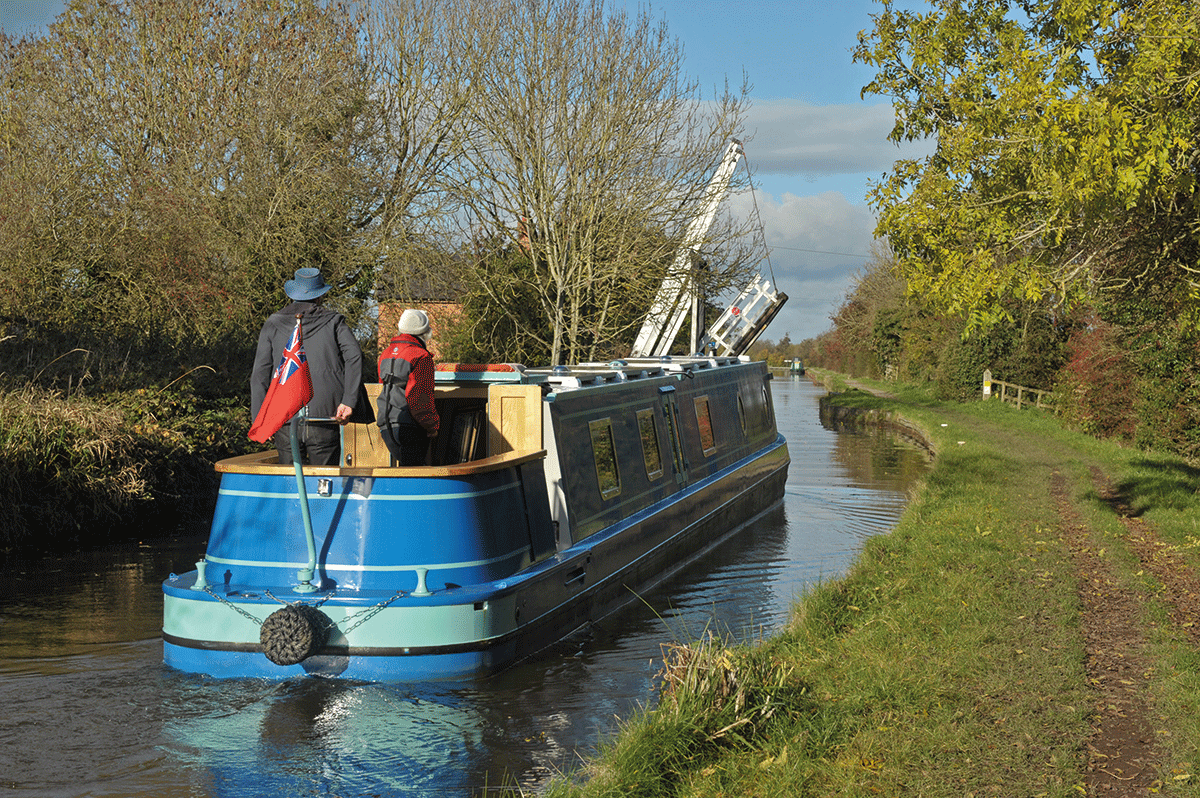
ON THE WATER
It doesn’t matter how many times we test a boat with electric drive, the quietness always comes as a really pleasant surprise. Rather than engine noise, you can hear the water round the prop, and trickling along the side of the boat. You can also hear what people are saying to you from the towpath. At the helm, there’s a Hybrid Marine display to tell you what proportion of the motor’s power you’re using, and what you’re taking out of the battery bank. On a summer’s day, the solar panels on the roof will be topping up the batteries at the same time.
The boat handles really well, as we’d expect from an MGM design and a Nick Thorpe build. Our route out of Whixall Marina and back in again tested the boat with lots of twists and turns, and we turned round without fuss at the end of the Prees Arm. The tiller is at a nice height, but as is usually the way on cruiser stern boats, the Morse control is quite low down.
The back deck is large enough for several crew to keep the helmsman company.
CONCLUSION
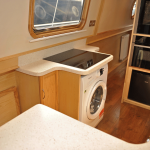 This boat is both very typical of what we’ve come to expect from MGM, and also very individual. The light ash fitout remains a contemporary choice, and the woodwork on show is pretty good. The layout, with the mid galley, off-corridor shower room, and twin beds in the cabin, are choices which suit the way the owners want to use the boat. The price comes in at around £220,000 – which although a lot of money is what you’d expect to pay for a hybrid drive boat these days. It has a hybrid system that gives the flexibility of either diesel or electric drive, and Graham has given a lot of thought to all aspects of it. Appliance-wise, the couple have made the most of that big battery bank by going all electric, with top of the range appliances.
This boat is both very typical of what we’ve come to expect from MGM, and also very individual. The light ash fitout remains a contemporary choice, and the woodwork on show is pretty good. The layout, with the mid galley, off-corridor shower room, and twin beds in the cabin, are choices which suit the way the owners want to use the boat. The price comes in at around £220,000 – which although a lot of money is what you’d expect to pay for a hybrid drive boat these days. It has a hybrid system that gives the flexibility of either diesel or electric drive, and Graham has given a lot of thought to all aspects of it. Appliance-wise, the couple have made the most of that big battery bank by going all electric, with top of the range appliances.
All in all, this boat should provide the owners with a great way of spending time on the water. It may not be quite as exhilarating as a sailing boat, but then lots of people (Sue included) will be grateful for that!
THE OWNERS
Sue and Grahan Heryet used to live near Worthing in West Sussex, which is why Graham was a keen sailor. They moved north to Shropshire 16 years ago after visiting family in the area, so they haven’t exactly rushed the decision to swap sailing boats for a narrowboat. Indeed, they’ve been talking to MGM for the past five years or so. The couple also used to keep horses, and it was selling a field they’re kept in West Sussex which paid for this boat; that was part of Halewick Farm, hence the name of the boat.
Although Graham trained as an engineer, and worked on hydraulics and electrical circuit design, he then spent 18 years in the police. Sue used to work for an electrical retailer in Chichester, in sales and admin.
The couple did a helmsman’s course a few years ago, not just to learn how to handle a narrowboat, but also to help Sue overcome her hatred of water. Graham says helming a narrowboat is completely different from sailing, and he’s still getting to grips with the finer points. But he’s well versed in lock operation, having been volunteering at Grindley Brook, the staircase locks on the Llangollen, for the past five years.
Specification
Length: 57ft
Beam: 6ft 10in
Shell: Nick Thorpe – 07933 769286
Style: Cruiser
Layout: Reverse
Berths: 2+2
Fit-out: Ash and painted panels
Engine: Hybrid Marine www.hybrid-marine.co.uk
Bow thrusters: Vetus 75kgf / www.vetus.com
Inverter: Victron 48 5kw / www.victronenergy.com
Oven: £629 – Neff slide and hide / www.neff-home.com/uk
Freezer: £129 – Abode ATTFZ1B / www.currys.co.uk
CONTACT
MGM Boats
Mill Lane Boat Yard,
Thurmaston, Leicester
LE4 8AF
01162 640009
mgmboatyard@gmail.com
www.mgmboats.co.uk
07377 152383
£220,000
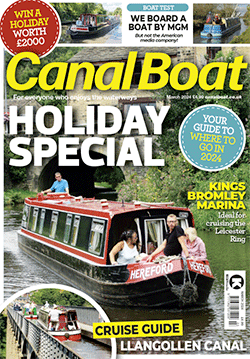 As featured in the March 2024 issue of Canal Boat. Buy the issue here
As featured in the March 2024 issue of Canal Boat. Buy the issue here

